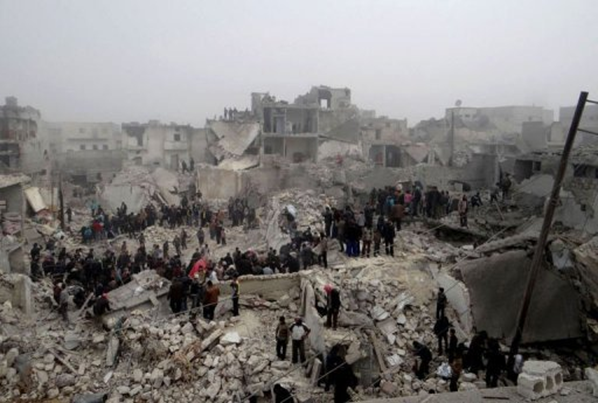
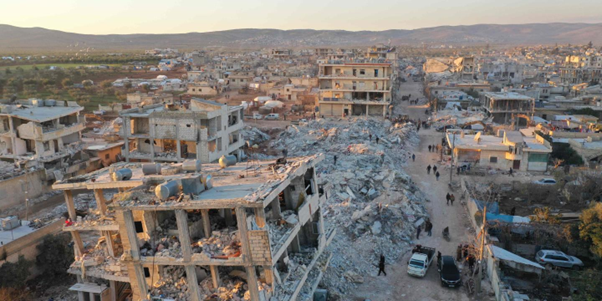
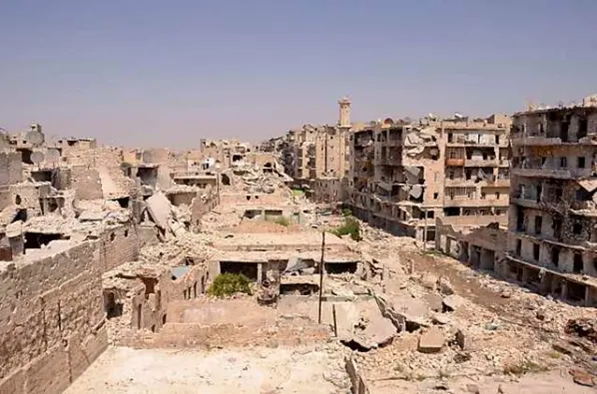
By Michael Karadjis
Following the 7.8 Richter earthquake of February 6, no disaster relief reached the people of northwest Syria, in the region under opposition control, from the United Nations or any country, in the crucial first week, meaning thousands died under the rubble. This was the part of Syria most heavily impacted by the quake. These people, who had already experienced the full brunt of years of horrific bombing by the Assad dictatorship and Imperial Russia with the full connivance of the “international community”, were yet again condemned to genocide by the world.
In the context of the quake, the Assad regime renewed its push for the lifting of US and EU economic sanctions on Syria. As I will argue in the second part of this series, there are good reasons to lift, or at least radically overhaul, these sanctions in their current form because, regardless of their intention and exemptions, they overwhelmingly impact the civilian population while the blood-drenched regime has consolidated. However, this has nothing to do with the current crisis over earthquake disaster relief.
It is very important that the genocidal regime – which has imposed the equivalent of hundreds of February 6 earthquakes on the people of Syria via its bombing of much of the country into a moonscape over the last decade, and which even bombed northwest Syria within hours after the earthquake, and has reportedly continued to do so since and even bombed Idlib on February 26-27 as the Egyptian foreign minister was meeting Assad – does not benefit from this disgraceful and hypocritical propaganda war. Because while 214 planeloads of disaster aid had arrived in regime-held Syria, via Damascus, Aleppo and Latakia airports, or via Beirut, as of February 24, from dozens of countries – completely unencumbered by sanctions which do not prevent such humanitarian aid – it is the much more heavily impacted northwest, outside regime control, that has been betrayed by the world, received very little, and initially left to die.
As UN Emergency Relief Coordinator Martin Griffiths noted, “The first 72 hrs after a disaster are critical” because this is when people buried under rubble may still be found alive, so the absence of aid in the first week cannot be fixed by (a little) more arriving the second week; as Jasmine Gani explained on February 9, “as a result of the slow international response and lack of aid, residents in Idlib have reported that most of the victims who are still alive and might have been saved are still trapped under the rubble after four days. Tragically, the sounds of people calling for help under the debris are slowly giving way to silence.”
That was obviously not due to sanctions on the regime, but on the contrary, to the regime’s sanctions on sending some of the enormous aid it did receive to the northwest; to the Russian veto in the UN on most cross-border aid crossings from Turkey into northern Syria to “protect Syria’s sovereignty”; and above all the decision by the UN, the US, the EU and others to “respect” this argument about Assadist “sovereignty” or UN “legality” by not sending aid direct to the region – or else back-handedly justifying their lack of aid with these arguments. The regime’s propaganda is so despicable that images of destruction in non-regime Idlib are shown with slogans against sanctions; most people have heard that little aid has reached the victims in northern Syria and hence the disgraceful lie that this is due to sanctions on the genocidal regime often sounds persuasive to those not in the know.
Background: The liberated northwest and years of Assadist terror-bombing
The Assad regime and Russia bombed the people here – as with elsewhere in Syria – for a decade with every conceivable form of “conventional” and unconventional WMD except nuclear, destroying entire cities and towns, turning much of the country into a moonscape, bombing hundreds of hospitals, but the people refused to submit. While the regime, with Russian and Iranian support and US connivance, reconquered most of the regions held by the anti-Assad revolution, two regions remain outside its control – the northwest (much of Idlib and Aleppo provinces), under the control of a range of rebel groups, and partially controlled by Turkish forces in an uneasy alliance with them, and the northeast, under the control of the Kurdish-led, US-backed Syrian Democratic Forces (SDF). Yes, the rebel leaderships in the northwest became heavily co-opted either by Turkey, or by the jihadist militia HTS, in the last few years, inevitable considering their desperation to not be overrun by the genocidal Assad regime, and the lack of support from the West; yet even over the last few months we’ve seen mass popular demonstrations both against Turkey and against HTS at different times, suggesting that, while militarily defeated, the revolutionary masses still believe they have something to fight for and remain committed to the ideals which they rose up for in 2011.
Indeed, while some of the demonstrations against HTS were simply against its attempt to impose its rule over areas it does not control, or against its repressive actions, others were against HTS attempting to open a trade connection with the regime; and similarly, the demonstrations against Turkey were against the growing convergence between Erdogan and Assad as they move to ‘bury the hatchet’, just as Erdogan has also recently moved to patch things up with his former enemies in the UAE, Saudi Arabia, Egypt and Israel (and just as the UAE, Egypt, Bahrain and increasingly Saudi Arabia have re-aligned with both the Assad regime and Israel in an axis of counterrevolution). But the 5 million people in the liberated northwest – including almost 3 million refugees from elsewhere in Syria – are both the main reason for Turkey maintaining some level of commitment to the anti-Assad cause when abandoned by everyone else – because, with 3.6 million Syrian refugees in Turkey already, Erdogan does not want Assad to reconquer the region and send millions more across the border – but therefore also the main obstacle to full Erdogan-Assad rapprochement, and the main potential victims of such a deal. If one were cynical one would suggest the earthquake was too good “an opportunity” for the regional oppressors via the sheer level of death, destruction and demoralisation meted out to the stubbornly resistant people of the region.
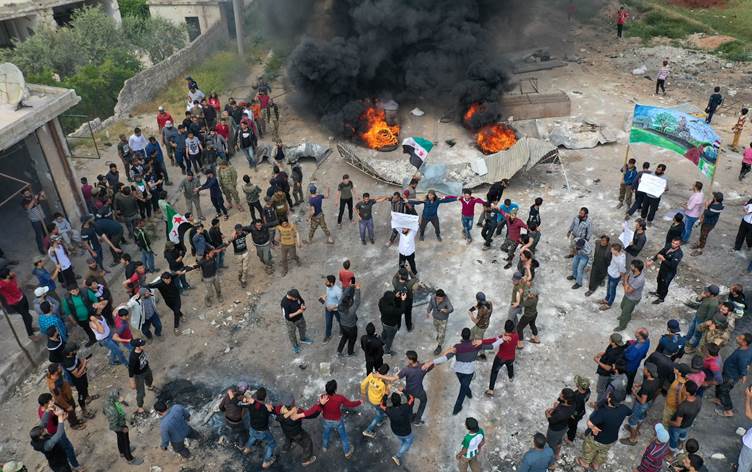
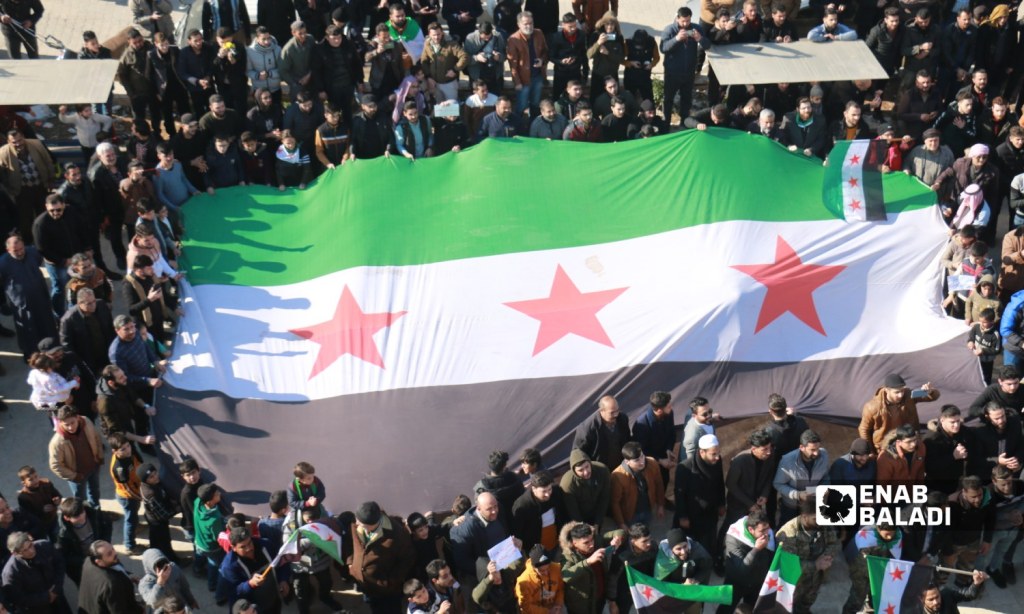
Left: demonstration against HTS trying to open trade links with regime; right, demonstration against Turkey trying to reconcile with regime
The impact: Turkey and the two parts of northwest Syria
Let’s clarify what is going on with the earthquake and its victims. Turkey suffered by far the biggest disaster, with over 44,000 killed and 345,000 apartments destroyed (some 160,000 buildings containing 520,000 apartments were either destroyed or severely damaged). Of these, the Syrian Network for Human Rights had already documented 3841 Syrian refugees in Turkey among the dead as of February 15, but at that point overall numbers were much lower so the real figure now may be much higher. The situation is unimaginable. But while no amount of disaster aid is enough, at least it has been arriving on a large-scale, and Turkey has a functioning government dealing with the situation, whatever one’s views on that government.
In Syria, despite relatively smaller numbers, the situation is even more drastic due to the lack of such a government and the politics of aid. Regions both under regime control, and under opposition control, in northwest Syria were heavily impacted by the earthquake; victims on both sides deserve all the aid they can get. But there are two differences: firstly, the level of devastation is far worse in the opposition-controlled regions (4300 dead, 7600 injured, 1700 buildings completely destroyed) than inside the Assad-ruled part (still tragic, 1408 deaths, 2301 injuries, dozens of destroyed buildings), as the opposition-controlled region is closer to the epicentre of the quake in Turkey; and second, thousands of tons of disaster relief have poured into Damascus since the earthquake struck, into the hands of the regime or of humanitarian organisations in regime territory, from dozens of countries from the very first days, whereas hardly anything arrived in the opposition-controlled northwest in the crucial first week after the quake when survivors may still have been found, and only a fraction of what the regime received has arrived since. To this we can add that the opposition region has been destroyed by years of Assadist and Russian bombing already, which not only killed and destroyed on a far vaster scale than the earthquake while also weakening the foundations of its buildings which have now collapsed, and meted out an incomprehensible level of destruction of its hospitals and health infrastructure which were ruthlessly and deliberately targeted; and the conditions the refugees were living in was already dire, before the earthquake hit: 1.7 million are living in refugee camps, while 4.1 million of the region’s population already rely on humanitarian aid.
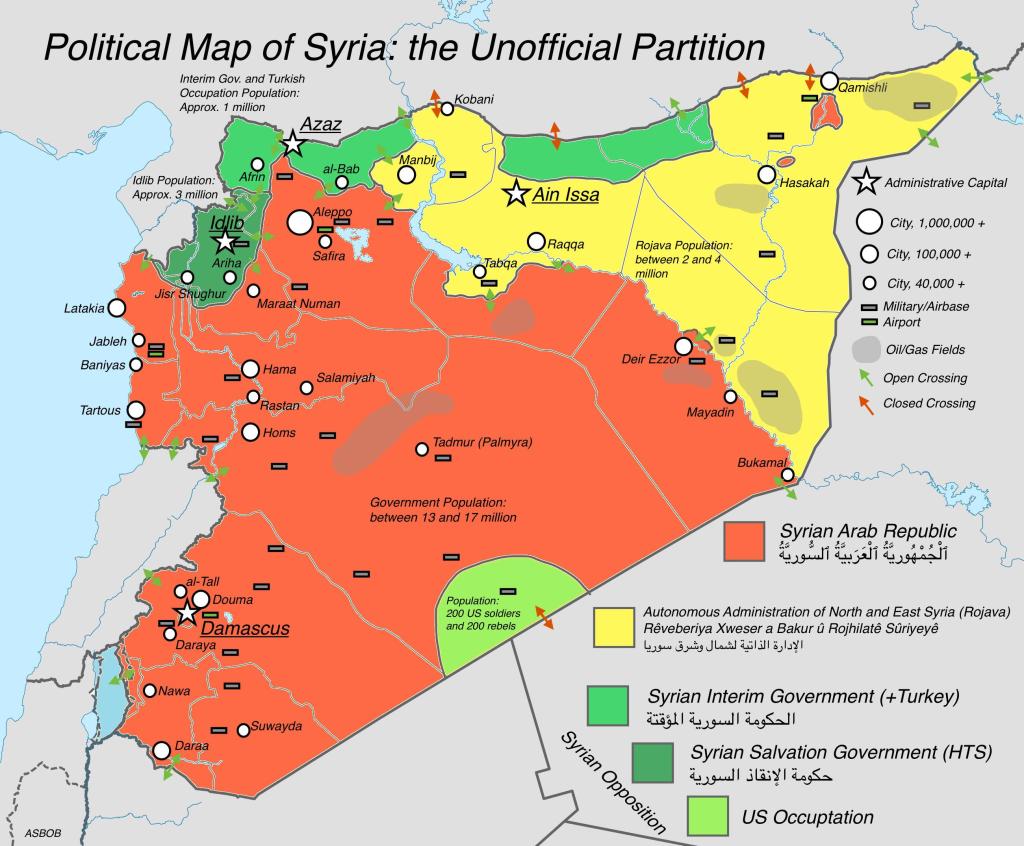
How can aid get to northwest Syria: its two “borders” and regime sanction on cross-border aid
So, how can aid get into liberated northwest Syria? Well, it has two borders. To the south is regime-controlled Syria. So while all the disaster aid going into Syria is a good thing, it is largely irrelevant to northwest Syria, because the Assad regime does not allow supplies to cross the boundary; “this area is an open-air prison that is disconnected from everywhere else,” according to Zaher Sahloul, the president of the aid organization MedGlobal, which works in the region and in Gaziantep in southern Turkey, home to thousands of Syrian refugees. The regime has also cut off electricity to the region, so search-and-rescue and medical services run on generators. Even within the region of Syria it does control, the regime has a well-documented history of directing aid to politically preferred regions. Nothing crossed the boundary in the first week, indeed, the Syrian Foreign Minister initially declared that no aid should get to what it called “the terrorists in the north,” ie, regions controlled by the rebels. On February 10, four days after the quake hit, the regime finally announced that it would let aid cross (called “cross-line” aid to distinguish it from the cross-border aid from Turkey), clearly timed to allow most under the rubble to die first, and then try to look good afterwards. In any case, only a trickle at most has been sent since the announcement, while even attempts by Syrian citizens to collect and send aid to the northwest, from various parts of Syria, have reportedly been thwarted.
The other border is to the north, the border with Turkey. Turkey has been the main provider to this region, but also, international organisations have accessed this region via Turkey. Turkey itself has 3.6 million Syrian refugees, the world’s largest refugee population, and most live in the region of Turkey just destroyed by the earthquake there. There were long two major routes from Turkey into this region of Syria for humanitarian relief (as well as smaller routes), plus a route from Iraq and one from Jordan. However, since 2020, Russia has blocked the routes from Jordan and Iraq and all but one of the routes from Turkey, via its UN veto. This “resulted in a lack of essential items, building materials and specialist equipment making it impossible to rebuild the region which was devastated by war and bombed by Syrian and Russian forces.” Even the one crossing Russia reluctantly allowed the stay open, the Bab al-Hawa crossing, has to be renewed every 6 months. However, this route was itself badly damaged by the earthquake, and for over a week after the quake, the Syrian regime insisted that all aid must flow through Damascus, even that to the region outside its control, and therefore refused to budge on the question of “allowing” other crossings from Turkey. And the UN did not use the other routes to get in urgent aid, due to this Russian UN veto and respect for this alleged “Syrian sovereignty”, despite the fact that several months ago, before the earthquake struck, a range of international legal experts had already declared that no UN or regime “permission” is needed to send urgent humanitarian aid across borders.
The first crucial week: Massive aid to Assad’s Syria, nothing for the northwest
Now, of course, the main villain here is Putin’s imperialist Russian regime blocking humanitarian corridors on behalf of the alleged “sovereignty” of its satrap in Damascus, and that satrap; however, given the scale of the disaster, the UN could simply have used the other crossings, and put saving lives ahead of such spurious “sovereignty” arguments, as these experts argued.
Not a single search and rescue team arrived in the northwest from anywhere in the world in the first week, and the existing equipment in the hands of the relief organisations such as the absolutely heroic White Helmets was only sufficient to search about 5 percent of impacted areas. According to reporter Ruth Sherlock on February 11, “on a rare visit to this rebel-held enclave of a country broken and isolated by more than a decade of civil war, NPR saw no international crews of rescuers; no trucks loaded with machinery or medical aid; no streams of ambulances to save the wounded. The border crossing into Syria was empty and silent.”
Meanwhile, the damage at the one legal opening did not prevent trucks crossing to bring back bodies of Syrian refugees from Turkey killed in the earthquake there – so why couldn’t relief get in as well as bodies? Some 22 trucks did cross the border on February 9, three days after the earthquake, but that was only to deliver goods ordered before the earthquake, namely backlog supplies of food, water and cleaning materials, hardly what was most pressing at the time. By the end of the first week, northwest Syria had only received five truck convoys, a mere 52 trucks, according to the UN Office for the Coordination of Humanitarian Affairs. This compared with 84 planes and 12 truck convoys that arrived in regime-held Syria by that same point, clearly unimpeded by sanctions. And what about airdrops – couldn’t the UN or US or EU have carried out airdrops of supplies? As Jasmine Gani points out, “in 2016, due to the extent of damage to the roads, the UN was able to airdrop hundreds of supplies to the regime-held area of Deir Ezzor, multiple times; but the UN must first seek approval from the regime, and with a lack of permission, no such airdrops have been made in the North-west of Syria.” So the UN simply capitulated to the regime and continued to send all its aid to regime areas. And couldn’t the US or EU have somewhat pressured the UN on this issue if they really wanted to get aid in, or made airdrops themselves – after all, the US has an airbase just across the border in Turkey. Indeed, Idrees Ahmad shows, both made fancy statements about sending aid to the disaster-hit zone in the first week, but nothing arrived. The fact that they didn’t, and that the UN, US and EU all preferred to send aid via the regime-controlled region, makes extra mockery of the idea that sanctions were preventing aid, as no sanctions prevented them sending aid via Turkey to the north.
Of the 84 planeloads of aid and 12 truck convoys that were sent to regime-held Syria in the first week, the absolute majority, 71, came from Arab countries. Of these by far the largest contribution came from the United Arab Emirates (UAE), which sent 22 planes and one truck convoy, while Iraq, Libya, Algeria, Oman, Egypt, Jordan, Saudi Arabia, Sudan and Tunisia all sent planes. In addition, another 15 planes came from a range of other countries, including the European Union and Italy. The story spread on some “anti-imperialist” sites that only “anti-imperialist” states sent aid was nothing but the laughable fiction we’ve come to expect from such quarters: depending on what this vague and hollow term is taken to mean, the 11 planes sent at this stage by Russia, China, Iran and Venezuela was relative peanuts. Russia, of course, had no trouble sending hundreds of warplanes to bomb Syria to bits for years, but only 3 planes for disaster relief. For many of the reactionary Arab states who sent the great bulk, especially the UAE, Egypt, Jordan and Oman, and partially Saudi Arabia, this massive aid has gone hand in hand with dramatically increasing their political rapprochement with the Assad regime (including top state visits to Assad and by Assad) which these states have been leading in the Arab world for years now; it is no coincidence that they are the same states which have led rapprochement with Israel in the same period. Only Qatar (which rejects rapprochement with either Assad or Israel) and Kuwait have focused their aid on the northwest.
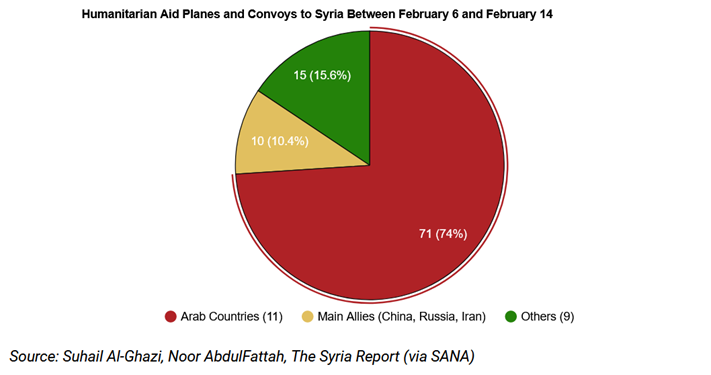
Chart showing the number of planes or convoys from different groups of countries (figure in brackets is number of countries)
Cross-border aid “allowed” but remains a relative trickle
Finally, on February 13, a week after the quake, the regime “gave permission” to the UN and other agencies to use the other crossings (Bab al-Salama and al-Rai) to deliver aid to the region it has no control over (apparently at the urging of its close UAE ally), again well-timed to allow maximum death first, and the UN, thanking “his Excellence” genocidal tyrant Assad for such magnanimity, finally delivered the first aid through the Bab al-Salama crossing on February 15.
By the end of the second week, 178 trucks had crossed the border from Turkey in the entire period since the quake hit, a big improvement which continued in the third week (282 trucks by February 24). However, while this may sound a lot, throughout 2022, “some 600 trucks loaded with aid crossed Türkiye each month” in normal times! Moreover, the contrast with the level of aid being sent to regime Syria remained stark: 167 planeloads of disaster aid had arrived in Syria, via Damascus, Aleppo and Latakia airports, in the region controlled by the Assad regime, as of February 18, rising to 214 planes as of February 24 (of which 93 were from the UAE). In fact, the number of trucks which arrived in the first two weeks in the northwest was equivalent to what sometimes arrived in regime-held Syria on a daily basis, for example, on February 18, a convoy of 100 Iraqi aid trucks crossed the Syrian border, plus trucks from various other countries, along with 17 planes, half from the UAE. To put it simply, almost as many planeloads arrived in regime-held Syria (in addition to trucks) as truckloads arrived in the far more impacted rebel-held Syria! Moreover, trucks mostly bring in aid such as food and tents rather than the specialist equipment required for search and rescue or construction materials to rebuild homes and buildings destroyed.
Actually, 120 trucks of aid collected by Syrians in Deir Ezzor, under the control of the SDF in northeast Syria (the Autonomous Administration of North and East Syria, AANES), which was sent to the northwest on February 14, exceeded the amount of aid sent by the United Nations at that point by two and a half times! The aid was transferred by AANES to the opposition Syrian Interim Government (SIG) which controls much of the northwest, despite their otherwise poor relations. Unfortunately, a second convoy of 30 tanks of fuel and 20 trucks of aid sent by AANES to the northwest was apparently blocked by the SIG, possibly due to Turkish pressure.
| First week | By February 18 | By February 24 | |
| Regime-held Syria | 84 planes + hundreds of trucks | 167 planes + hundreds of trucks | 214 planes + hundreds of trucks |
| Rebel-held northwest | 0 | 178 trucks | 282 trucks |
So, what about the sanctions on the Assad regime?
Given all the above, it appears deeply ironic that the Assad regime is attempting to use this disaster to press for the end of US (and EU) sanctions on the regime, which were imposed in their current harsh form in 2019 after the US had facilitated Assad’s military victory over the armed opposition. This will be elaborated on in the second article of this series, focused on the sanctions.
The key point here is that, while there are good reasons to demand the end, or at least the radical overhaul, of the sanctions in their current form, this question has nothing to do with the current disaster relief issue. Therefore, raising that argument in the midst of the disaster played into the hands of the genocidal regime and its lies. It is abundantly clear from all the above data that the sanctions were not preventing any aid from getting into Assad’s Syria: on the contrary, as massive aid poured in, it was opposition-controlled Syria that was both most devasted, and receiving very little aid, where avoidable mass death took place. And part of the reason for this was the effective ‘sanctions’ imposed by the Assad regime on aid to the northwest, the UN veto imposed by its Russia paymaster on cross-border aid to the northwest, and above all the loyalty of the UN system to these legal fictions of Assadist “sovereignty” and Putinite “legality”, trumping the survival of thousands of Syrians under the rubble.
Regime Syria could receive all these hundreds of planes with thousands of tons of disaster relief from around the world precisely because the sanctions already exempt humanitarian and medical supplies, as the Assad regime’s foreign minister concedes. In any case, both the EU and the US have suspended any sanctions that could conceivably impact or hold up deliveries for the next 6 months in response to the disaster (the difference this makes therefore, is unclear, but the idea is to expedite aid delivery so that it doesn’t have to go through any process to get clearance first). Moreover, the major UN humanitarian operation inside Syria (coordinated by the United Nations Office for the Coordination of Humanitarian Affairs), working in all Syrian provinces, received 44.7% of its $2.362 billion funding in 2022 from the US! And similar amounts every year. Indeed 91% of the UN humanitarian funding in Syria comes from the US, UK, EU and Canada – all of which sanction the regime. They do not sanction their own humanitarian funding now do they? Indeed, USAID has provided $16 billion in humanitarian aid to Syria since the crisis began in 2011, working in all Syrian provinces. The US has also pledged $185 million to Turkey and Syria in disaster relief for the current earthquake. The problem is more that the Assad regime has a well-documented history of stealing, manipulating, diverting all this aid going into Syria via the UN, so that much of it does not reach the intended targets, with the UN awarding nearly half of its procurement contrasts to individuals closely connected to the Assad regime in a situation described as “systematic corruption” in a 2022 report commissioned by the Syrian Legal Development Program (SLDP) and the Observatory of Political and Economic Networks (OPEN).
Therefore, given this combination of facts – the massive disaster relief sent to regime Syria unimpeded by sanctions, the corresponding catastrophic lack of disaster relief being sent to the rebel-held northwest which had borne the main brunt of the disaster, the fact that regime ‘sanctions’ on aid to the northwest and Russian UN veto on cross-border aid corridors worsened the situation of the northwest, the ongoing bombing of the earthquake-hit northwest by the regime, the regime’s theft and manipulation of aid, and the fact that this regime had bombed its country to ruins far, far exceeding what any earthquake could do – the opportunist campaign to use the disaster to call for the end of sanctions on the genocidal regime was deeply flawed and hypocritical, based on lies, and aimed at the regime’s rehabilitation rather than aiding earthquake victims.
But as long as we separate this issue from the current disaster, there are nevertheless good reasons to take a hard look at this question of US and EU sanctions on the regime in their current form. The assessment now that 3-4 years have elapsed appears to be: on the one hand, the ordinary Syrian people feel the major impact of sanctions, because, despite their exemptions, they impact humanitarian relief in countless indirect ways, especially in relation to the banking system, and sanctions on entire sections of the economy (eg energy) inevitably batter the poor regardless of intentions; on the other, the regime appears firmly entrenched in power and its oligarchic circles have always been in the best position to evade, or even profit from, sanctions. This however comes up against the question of, if not sanctions, what can be done with a regime that has destroyed its country, killed hundreds of thousands, still holds tens of thousands of political prisoners in horrific conditions involving systematic torture, while a quarter of the population have fled the country and will not return while Assad remains in power, and more than half of Syria’s pre-war population are outside regime control. This will be discussed in the second part of this series.